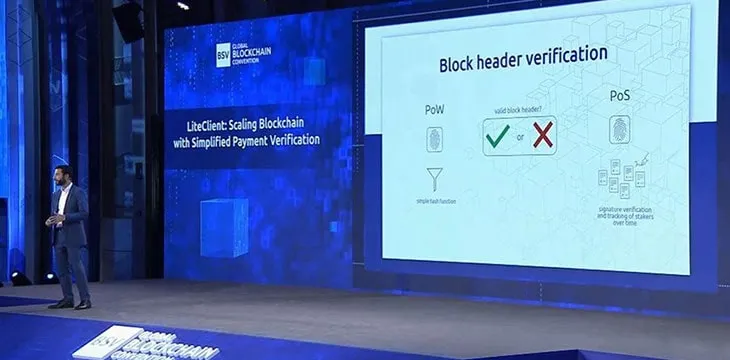|
Getting your Trinity Audio player ready...
|
https://youtu.be/-j9Kvvm2xxc
It’s no secret that the question of how to scale Bitcoin has been a topic of hot debate in years gone by. However, many don’t understand that Bitcoin could always scale to global dimensions: Satoshi Nakamoto designed it that way. Jad Wahab joined the BSV Global Blockchain Convention to explain how to scale Bitcoin with Simplified Payment Verification (SPV).
Who is Jad Wahab?
Jad Wahab is the Director of Engineering at the BSV Blockchain Association. He’s involved in decision-making and design related to all sorts of technical matters, especially related to BSV infrastructure. He previously worked at nChain in a similar capacity.

Satoshi’s answer to scaling: Simplified Payment Verification
Wahab begins by outlining that in section 8 of the Bitcoin white paper, Satoshi Nakamoto answered the question as to how Bitcoin could scale via something called Simplified Payment Verification. This is ignored by many Bitcoin advocates today, but it’s a key part of how BSV plans to scale to global dimensions, handling enterprise-level volumes of transactions and data.
It’s possible to verify payments without running a full network node. – Satoshi Nakamoto, Bitcoin Whitepaper, section 8
Using SPV to keep track of relevant transactions, users can send and receive payments, write data to the blockchain, and read data/ensure it hasn’t changed. It’s completely unnecessary to run a full node and download everyone’s payment data, and trying to do this on a laptop or PC is going to lead to technical issues. SPV was always the solution for individuals, merchants, and other users, Wahab tells us.
Proof of work and mining
So-called ‘third generation’ blockchains often use the proof of stake (PoS) consensus mechanism. They take aim at proof of work’s (PoW) environmental impact and claim it is outdated, but Wahab explains that PoW is essential for scaling; it’s only with it that users can run SPV.
“Complexity is the enemy of security,” Wahab remarks.

Diving deeper, Wahab explains that the blockchain is a global timeline verifying all of the world’s transactions and data. Users only need a chain of headers, which he likens to fingerprints, which are 80 bytes each. Storing 80 bytes every 10 minutes is easy—even a picture sent over a messaging app today is thousands of bytes. Therefore, there’s no need for many blockchains. Everything can stay on one global chain, which can grow infinitely thanks to the small size of the block headers. Everything remaining on the blockchain will usher in an unprecedented era of transparency, traceability, and data integrity.
Driving his point home, Wahab tells us that block headers require PoW. It’s necessary to run the block headers through a valid hash function to verify them. This isn’t possible on PoS systems, which are much more complex and burdensome. Wahab doesn’t delve into the many flaws of PoS in this presentation, but they’re well known and have been outlined elsewhere.
LiteClient and the LiteClient Toolbox
True peer-to-peer connectivity or direct communication between users (LiteClients) allows Bitcoin to scale to global dimensions. This is what Satoshi Nakamoto originally envisioned, and this is what BSV blockchain has made possible.

Wahab announces that to foster correct usage of Bitcoin in this way, the BSV Blockchain Association has released a LiteClient Toolbox. This will allow users to easily learn how it works, interact with the blockchain, and scale their businesses without wading through the technical weeds. It’s a simple interface designed with non-specialists in mind. The ultimate goal is to break down digital walls and have wallets, token platforms, and payment channels communicating directly with one another.
Wahab emphasizes that this is only the start. The LiteClient program is in development, and it addresses many other issues that users have when using the BSV blockchain. Ultimately, Wahab and his team are laying foundations and building infrastructure that will replace the need to run a full node and will make it much easier for users to run SPV as intended.
Watch the BSV Global Blockchain Convention Dubai 2022 Day 1 here:
https://youtu.be/ggbZ8YedpBE

 07-05-2025
07-05-2025 





